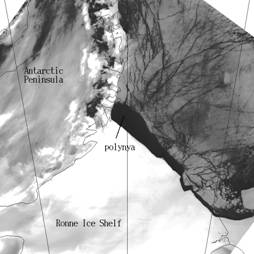Air-sea-ice interactions within coastal polynyas in the southern Weddell Sea
Supervisers - Ian Renfrew, John King (BAS) and Keith Nicholls (BAS)
Air-sea-ice interactions within coastal polynyas (areas of persistent open water generated along the coast due to wind forcing or oceanic heating – see Figure) are an important component of the water mass modification processes that take place on the continental shelves around Antarctica. Coastal polynyas are blown open by the advection of sea ice offshore due to strong surface winds, then, during the wintertime, they rapidly refreeze due to the large air-sea heat fluxes induced by cold continental air flowing over relatively warm ocean surface. Consequently coastal polynyas produce large amounts of sea ice, e.g. on average 24 m of sea ice per unit area in the southern Weddell Sea. Upon freezing, sea water rejects salt, leaving the sea ice relatively fresh and the modified water column relatively salty. Quantifying the amount of heat and moisture exchanged within coastal polynyas is a key step to quantifying the amount of High Salinity Shelf Water formed and subsequently the amount of deep water formed. It is thus vital for a better understanding of water mass modifications around Antarctica and the processes that make up the global thermohaline circulation.
In developing a climatology of the surface heat exchange within coastal polynyas, Renfrew et al. (2002), employed observations from an in situ Automatic Weather Station, data extracted from global meteorological analyses, satellite imagery of the sea ice distribution, and a number of simple, yet elegant, physical and statistical models (e.g. Renfrew and King 2000). Unfortunately their study did not attempt to quantify the surface moisture exchange within coastal polynyas, the stumbling blocks being the poor knowledge of precipitation over the sea ice zone, the unknown quantity of snow blown from the ice sheet into the water, ice shelf melt, and so on. This project will tackle these uncertainties. Precipitation estimates will be derived from in situ observations, meteorological analyses, and satellite products. While blowing snow estimates will be made using simple blowing snow models, driven by observations. Simple models of ice sheet melt will also be used. Thus a comprehensive climatology of both surface heat and moisture exchange will be calculated, enabling an estimate of buoyancy fluxes due to coastal polynyas in the southern Weddell Sea. If time allows, these techniques could be extended to examine other geographic areas prone to coastal polynyas or extended in time. There may be an opportunity for aircraft-based fieldwork in Antarctica, measuring air-sea heat and moisture fluxes over the sea ice zone, through work being carried out as part of the ACES- FOCAS project, part of BAS’s core programme. The observations used will enable the validation and tuning of some of the simple models used to develop the climatology.
There may be an opportunity for aircraft-based fieldwork in Antarctica, measuring air-sea heat and moisture fluxes over the sea ice zone, through work being carried out as part of the ACES- FOCAS project, part of BAS’s core programme. The observations used will enable the validation and tuning of some of the simple models used to develop the climatology.
Renfrew, I. A. and J. C. King, 2000: A simple model of the convective internal boundary layer and its application to surface heat flux estimates within polynyas, Boundary-Layer Meteorol., 94, 335-356.
Renfrew, I. A., J. C. King, and T. Markus, 2002: Coastal polynyas in the southern Weddell Sea: variability of the surface energy budget, J. Geophys. Res. (Oceans), 107 (C6), 3063, doi: 10.1029/2000JC000720.
 There may be an opportunity for aircraft-based fieldwork in Antarctica, measuring air-sea heat and moisture fluxes over the sea ice zone, through work being carried out as part of the ACES- FOCAS project, part of BAS’s core programme. The observations used will enable the validation and tuning of some of the simple models used to develop the climatology.
There may be an opportunity for aircraft-based fieldwork in Antarctica, measuring air-sea heat and moisture fluxes over the sea ice zone, through work being carried out as part of the ACES- FOCAS project, part of BAS’s core programme. The observations used will enable the validation and tuning of some of the simple models used to develop the climatology.